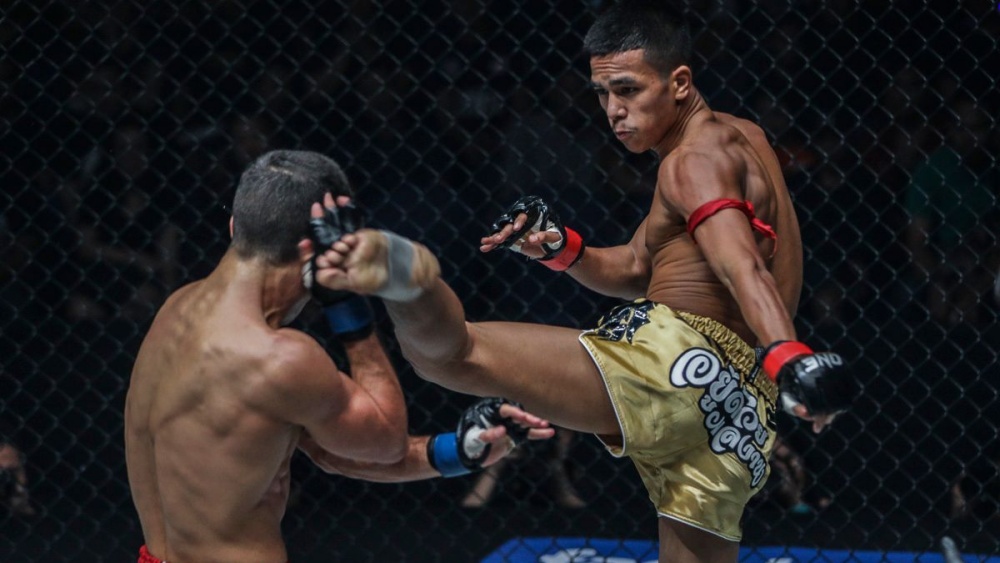The question mark kick is used in combat sports like Muay Thai, kickboxing, and karate. It is a deceptive technique that fools your opponent into thinking you’re attacking low when your intended target is high.
It’s an advanced Muay Thai technique, but it’s a straightforward move to master.
The origins of the question mark kick aren’t as clear as its effectiveness. Some people believe the technique comes from karate, while others claim it comes from Muay Thai. The former is more likely since the question mark kick uses a snapping motion, like many karate kicking techniques. Muay Thai fighters typically kick through their target instead of using their legs as whips. The question mark kick requires you to snap your kick karate style.
While the origins of the question mark kick aren’t clear, its effectiveness has been proven on various testing grounds, from mixed martial arts to high-level Muay Thai fights.
Understanding The Question Mark Kick
Landing the question mark kick is all about deception and fast-twitch motion. The technique starts like a regular low kick; then, you surprise your opponent by suddenly aiming higher halfway into the motion. The key to catching an opponent off guard with the question mark kick is to set up the attack with low or front kicks.
Fire one or two hard low kicks to your opponent so they start checking your kicks. Once your opponent starts expecting low kicks, switch things up with a question mark kick.
To execute the technique, you bring your knee up while throwing a low kick and redirect your legs, so it impacts your opponent’s chin. The quick shift redirects the force of the kick to its real intended target. The kick lands with enough power to end a fight when executed correctly.
Let’s take a look at some of the different ways to incorporate this technique into your arsenal:
1) Question Mark Kick With Your Back Leg
This is one of the most straightforward question mark kick variations to master since it involves kicking with your rear leg. That’s the leg you first learn to throw most kicks with when you start training any striking art, so the movement shouldn’t feel awkward to you.
A good setup for this question mark kick is a front kick or body kick. That gets your opponent expecting more attacks aimed at their midsection. Here’s what the technique looks like:
- Bring your knee up and pivot your front foot to open up your hips as you throw the kick.
- Start like you’re going to the torso, then redirect your leg so that the ball of your foot strikes your opponent’s chin as you snap your leg like a whip.
2) The Lead Leg Question Mark Kick
The mechanics of this technique are the same as the rear question mark kick. You also have to sell it by setting up the attack. A calf kick or lead front kick are excellent setups for this technique. Here’s what it looks like:
- From your fighting stance, bring up your lead knee as if you were getting ready to throw a front kick.
- Throw the kick like you’re aiming for the lower part of their body and pivot your backfoot to open up your hips.
- Redirect the kick towards your opponent’s chin as they drop their guard to protect their body.
3) Question Mark Kick Thrown Off Body Kicks
A roundhouse kick to the body is an effective way to set up the question mark kick, especially if you’re good at landing powerful body kicks. Those things sting, so it doesn’t take much before your opponent starts dropping their hands to protect their body.
To execute the technique:
- Set up your attack with a few hard roundhouse kicks to the body. Make sure you turn your hips, feet, and torso and try to kick through your opponent.
- Once your opponent starts blocking your body kicks, bring your knee up and pause for a second. The pause is a crucial part of the technique since you want your opponent to prepare to defend against a kick to the body.
- Redirect the kick once your opponent drops their guard, making impact with the ball of your feet. The kick goes up and over your opponent’s guard and connects with their chin when executed correctly. The movement of your legs looks like a question mark, hence the name of the technique.
4) Setting Up A Question Mark Kick With Both Legs
Here’s an advanced way to set up a question mark kick. You need to perform many drills to make this technique a part of your arsenal, but you end up with a potential fight-ending combination. Here’s what it looks like:
- Start by throwing a basic jab, cross combination to your opponent’s head. This gets your opponent thinking the following attacks are coming at their head.
- Now, throw a front kick at their body and immediately follow it up with a question mark kick. Your opponent will be disoriented at that point, making it easier to land the kick.
5) Question Mark Kick Low Kick
You don’t have to always aim for the head when throwing a question mark kick. You can reverse the technique and use it to land a powerful low kick. Here’s what the technique looks like:
- Set up the kick by throwing a few high kicks to your opponent’s head. In response, they will likely bring their guard up to protect them against other attacks.
- Now, bring your knee up as if you were throwing another kick to the head.
- Direct the kick downward at the last moment, landing with your shins. Remember to turn your lead foot and hips as you execute the technique to ensure it lands with maximum power. The downward motion of this technique can be quite debilitating to opponents, restricting their movement.
You may also like:


















